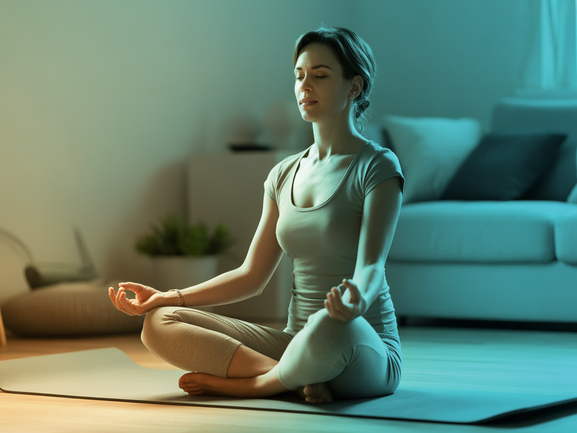7 Simple Meditation Tips for Beginners: Transform Your Home Into a Sacred Space
Picture this: you’re scrolling through your phone at 8 PM, feeling overwhelmed by the day’s chaos, when suddenly you realize you haven’t taken a single mindful breath all day. Sound familiar? You’re not alone. In our fast-paced world, finding inner peace can feel like searching for a needle in a haystack. However, the good news is that meditation and mindfulness practices can be your gateway to tranquility – right from the comfort of your own home.
Moreover, research consistently shows that regular meditation practice reduces stress, improves focus, and enhances overall well-being. Whether you’re a complete beginner or someone looking to deepen your practice, these practical tips will help you establish a sustainable home meditation routine that fits seamlessly into your lifestyle.
Why Start Meditating at Home?
First and foremost, home meditation offers unparalleled convenience and comfort. Unlike studio classes, you can practice whenever it suits your schedule. Additionally, creating your own sacred space allows you to personalize your environment, making your practice more meaningful and consistent.
Furthermore, studies published in the Journal of Health Psychology demonstrate that even short, daily meditation sessions can significantly reduce cortisol levels and improve emotional regulation. Consequently, establishing a home practice becomes not just a luxury, but a necessity for optimal mental health.
7 Essential Meditation Tips for Beginners
1. Start Small and Be Consistent
When beginning your meditation journey, it’s tempting to aim for hour-long sessions. However, consistency trumps duration every time. Start with just 5-10 minutes daily, then gradually increase as your practice strengthens.
Most importantly, choose a specific time each day for your practice. Whether it’s first thing in the morning or before bed, routine creates habit. Research from the American Psychological Association shows that it takes approximately 66 days to form a new habit, so patience and persistence are key.
2. Create Your Sacred Meditation Space
Your environment significantly impacts your mindfulness practice. Designate a specific corner or room in your home exclusively for meditation. This doesn’t require a complete room makeover – even a small cushion in a quiet corner works perfectly.
Consider these elements for your space:
- A comfortable cushion or mat
- Soft, natural lighting or candles
- Minimal distractions (put that phone away!)
- Perhaps some plants or meaningful objects
- Essential oils or incense for aromatherapy
Remember, the goal is creating an environment that signals to your brain: “It’s time to relax and focus.”
3. Master the Art of Breathing
Breathing techniques form the foundation of effective meditation. The 4-7-8 technique is particularly powerful for beginners:
- Inhale through your nose for 4 counts
- Hold your breath for 7 counts
- Exhale through your mouth for 8 counts
- Repeat 4-6 cycles
Additionally, diaphragmatic breathing helps activate your parasympathetic nervous system, naturally inducing relaxation. Place one hand on your chest and another on your belly – the goal is to breathe so that your belly hand moves more than your chest hand.
4. Find Your Perfect Posture
Contrary to popular belief, you don’t need to sit in lotus position to meditate effectively. The key is finding a posture that’s both comfortable and alert. Here are several options:
- Chair sitting: Feet flat on floor, spine straight
- Cushion sitting: Cross-legged with hips slightly elevated
- Kneeling: Using a meditation bench or cushion
- Walking meditation: Slow, mindful movement
Whatever position you choose, maintain a straight spine while keeping your shoulders relaxed. Think “dignified but not rigid.”
5. Embrace Wandering Thoughts
Here’s a game-changer for beginner meditation: your mind is supposed to wander. That’s what minds do! Instead of fighting your thoughts, acknowledge them gently and return your focus to your breath or chosen anchor.
Think of thoughts like clouds passing through the sky of your mind. You notice them, you don’t judge them, and you let them drift by. This non-judgmental awareness is the heart of mindfulness practice.
6. Use Guided Meditations
For beginners, guided meditations provide invaluable structure and support. A gentle voice walking you through the process can make all the difference in establishing your practice. Vitalizen.app offers a comprehensive library of guided sessions specifically designed for home practice, ranging from basic breathing exercises to more advanced mindfulness techniques.
Guided meditations also help you explore different styles:
- Body scan meditations
- Loving-kindness practices
- Visualization techniques
- Mindful movement sessions
7. Track Your Progress and Be Patient
Keep a simple meditation journal noting:
- Duration of each session
- How you felt before and after
- Any insights or challenges
- Gradual improvements in daily stress levels
Remember, meditation benefits accumulate over time. Some days will feel easier than others, and that’s completely normal. The key is showing up consistently, regardless of how you feel.
Building Your Daily Mindfulness Practice
Beyond formal sitting meditation, you can integrate mindfulness practices throughout your day:
- Mindful eating: Pay attention to tastes, textures, and sensations
- Walking meditation: Focus on each step and breath
- Mindful transitions: Take three conscious breaths between activities
- Body awareness: Regular check-ins with physical sensations
These micro-practices reinforce your formal meditation sessions and help cultivate a more mindful approach to daily life.
Frequently Asked Questions About Meditation
How long should I meditate as a beginner?
Start with 5-10 minutes daily. This duration is manageable for beginners while still providing benefits. As your practice develops, you can gradually increase the time.

